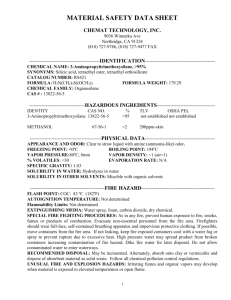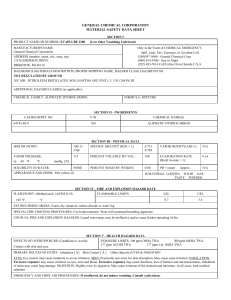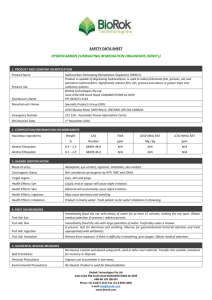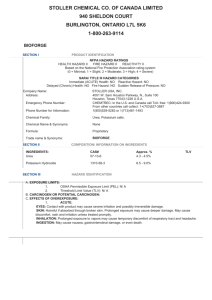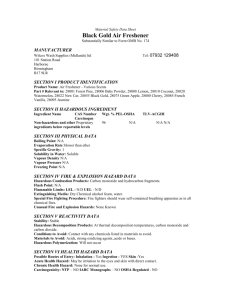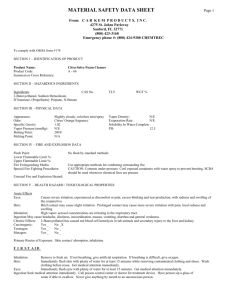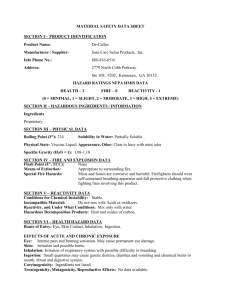AVGAS - Puma Energy
advertisement
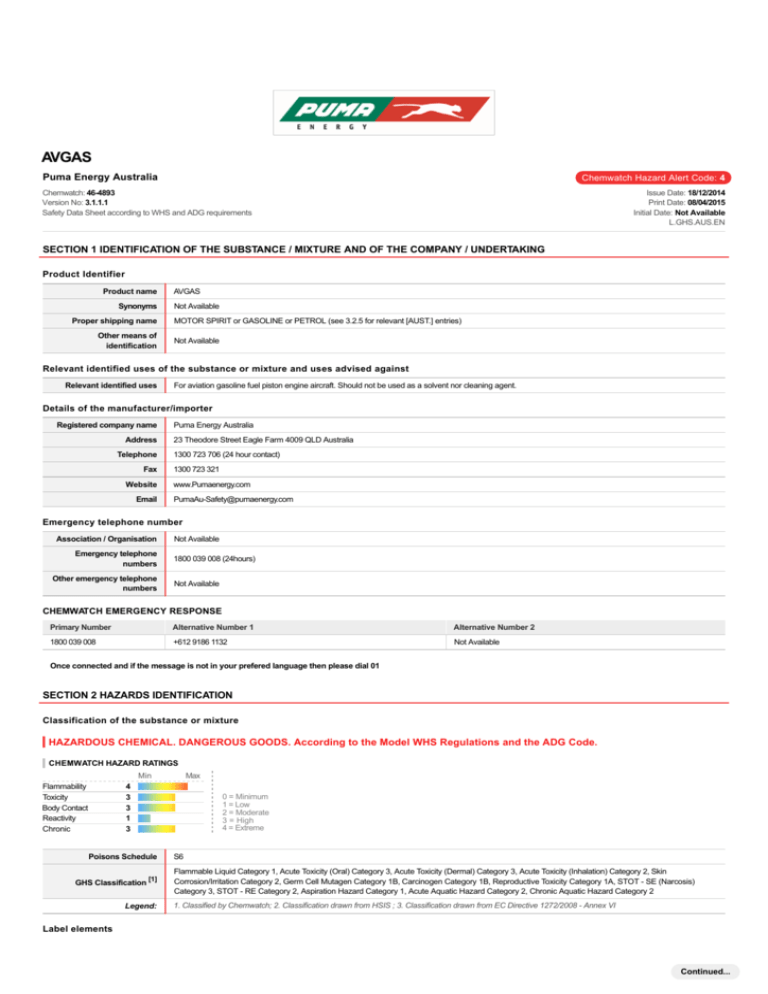
AVGAS Puma Energy Australia Chemwatch Hazard Alert Code: 4 Chemwatch: 46-4893 Version No: 3.1.1.1 Safety Data Sheet according to WHS and ADG requirements Issue Date: 18/12/2014 Print Date: 08/04/2015 Initial Date: Not Available L.GHS.AUS.EN SECTION 1 IDENTIFICATION OF THE SUBSTANCE / MIXTURE AND OF THE COMPANY / UNDERTAKING Product Identifier Product name Synonyms Proper shipping name Other means of identification AVGAS Not Available MOTOR SPIRIT or GASOLINE or PETROL (see 3.2.5 for relevant [AUST.] entries) Not Available Relevant identified uses of the substance or mixture and uses advised against Relevant identified uses For aviation gasoline fuel piston engine aircraft. Should not be used as a solvent nor cleaning agent. Details of the manufacturer/importer Registered company name Address Telephone Fax Website Email Puma Energy Australia 23 Theodore Street Eagle Farm 4009 QLD Australia 1300 723 706 (24 hour contact) 1300 723 321 www.Pumaenergy.com PumaAu-Safety@pumaenergy.com Emergency telephone number Association / Organisation Emergency telephone numbers Other emergency telephone numbers Not Available 1800 039 008 (24hours) Not Available CHEMWATCH EMERGENCY RESPONSE Primary Number Alternative Number 1 Alternative Number 2 1800 039 008 +612 9186 1132 Not Available Once connected and if the message is not in your prefered language then please dial 01 SECTION 2 HAZARDS IDENTIFICATION Classification of the substance or mixture HAZARDOUS CHEMICAL. DANGEROUS GOODS. According to the Model WHS Regulations and the ADG Code. CHEMWATCH HAZARD RATINGS Min Flammability Toxicity Body Contact Reactivity Chronic Max 4 3 3 1 3 Poisons Schedule GHS Classification [1] Legend: 0 = Minimum 1 = Low 2 = Moderate 3 = High 4 = Extreme S6 Flammable Liquid Category 1, Acute Toxicity (Oral) Category 3, Acute Toxicity (Dermal) Category 3, Acute Toxicity (Inhalation) Category 2, Skin Corrosion/Irritation Category 2, Germ Cell Mutagen Category 1B, Carcinogen Category 1B, Reproductive Toxicity Category 1A, STOT - SE (Narcosis) Category 3, STOT - RE Category 2, Aspiration Hazard Category 1, Acute Aquatic Hazard Category 2, Chronic Aquatic Hazard Category 2 1. Classified by Chemwatch; 2. Classification drawn from HSIS ; 3. Classification drawn from EC Directive 1272/2008 - Annex VI Label elements Continued... Chemwatch: 46-4893 Page 2 of 12 Version No: 3.1.1.1 AVGAS Issue Date: 18/12/2014 Print Date: 08/04/2015 GHS label elements SIGNAL WORD DANGER Hazard statement(s) H224 Extremely flammable liquid and vapour H301 Toxic if swallowed H311 Toxic in contact with skin H330 Fatal if inhaled H315 Causes skin irritation H340 May cause genetic defects H350 May cause cancer H360 May damage fertility or the unborn child H336 May cause drowsiness or dizziness H373 May cause damage to organs through prolonged or repeated exposure H304 May be fatal if swallowed and enters airways H401 Toxic to aquatic life H411 Toxic to aquatic life with long lasting effects Precautionary statement(s) Prevention P201 Obtain special instructions before use. P210 Keep away from heat, hot surfaces, sparks, open flames and other ignition sources. No smoking. P260 Do not breathe dust/fume/gas/mist/vapours/spray. P270 Do not eat, drink or smoke when using this product. P271 Use only outdoors or in a well-ventilated area. P280 Wear protective gloves/protective clothing/eye protection/face protection. P273 Avoid release to the environment. P284 [In case of inadequate ventilation] wear respiratory protection. P240 Ground/bond container and receiving equipment. P241 Use explosion-proof electrical/ventilating/lighting/intrinsically safe equipment. P242 Use only non-sparking tools. P243 Take precautionary measures against static discharge. Precautionary statement(s) Response P301+P310 IF SWALLOWED: Immediately call a POISON CENTER/doctor/physician/first aider P304+P340 IF INHALED: Remove person to fresh air and keep comfortable for breathing. P308+P313 IF exposed or concerned: Get medical advice/attention. P330 P331 Rinse mouth. Do NOT induce vomiting. P370+P378 In case of fire: Use alcohol resistant foam or normal protein foam for extinction. P302+P352 IF ON SKIN: Wash with plenty of water and soap P361+P364 Take off immediately all contaminated clothing and wash it before reuse. P391 P303+P361+P353 P332+P313 Collect spillage. IF ON SKIN (or hair): Take off immediately all contaminated clothing. Rinse skin with water/shower. If skin irritation occurs: Get medical advice/attention. Precautionary statement(s) Storage P403+P233 Store in a well-ventilated place. Keep container tightly closed. P403+P235 Store in a well-ventilated place. Keep cool. P405 Store locked up. Precautionary statement(s) Disposal P501 Dispose of contents/container to authorised chemical landfill or if organic to high temperature incineration SECTION 3 COMPOSITION / INFORMATION ON INGREDIENTS Substances See section below for composition of Mixtures Continued... Chemwatch: 46-4893 Page 3 of 12 Version No: 3.1.1.1 Issue Date: 18/12/2014 Print Date: 08/04/2015 AVGAS Mixtures CAS No %[weight] Name 86290-81-5 >99 gasoline 78-00-2 0-0.125 tetraethyl lead SECTION 4 FIRST AID MEASURES Description of first aid measures Eye Contact Skin Contact Inhalation Ingestion If this product comes in contact with the eyes: Immediately hold eyelids apart and flush the eye continuously with running water. Ensure complete irrigation of the eye by keeping eyelids apart and away from eye and moving the eyelids by occasionally lifting the upper and lower lids. Continue flushing until advised to stop by the Poisons Information Centre or a doctor, or for at least 15 minutes. Transport to hospital or doctor without delay. Removal of contact lenses after an eye injury should only be undertaken by skilled personnel. If skin or hair contact occurs: Quickly but gently, wipe material off skin with a dry, clean cloth. Immediately remove all contaminated clothing, including footwear. Wash skin and hair with running water. Continue flushing with water until advised to stop by the Poisons Information Centre. Transport to hospital, or doctor. If fumes or combustion products are inhaled remove from contaminated area. Lay patient down. Keep warm and rested. Prostheses such as false teeth, which may block airway, should be removed, where possible, prior to initiating first aid procedures. Apply artificial respiration if not breathing, preferably with a demand valve resuscitator, bag-valve mask device, or pocket mask as trained. Perform CPR if necessary. Transport to hospital, or doctor, without delay. IF SWALLOWED, REFER FOR MEDICAL ATTENTION, WHERE POSSIBLE, WITHOUT DELAY. For advice, contact a Poisons Information Centre or a doctor. Urgent hospital treatment is likely to be needed. In the mean time, qualified first-aid personnel should treat the patient following observation and employing supportive measures as indicated by the patient's condition. If the services of a medical officer or medical doctor are readily available, the patient should be placed in his/her care and a copy of the MSDS should be provided. Further action will be the responsibility of the medical specialist. If medical attention is not available on the worksite or surroundings send the patient to a hospital together with a copy of the MSDS. Where medical attention is not immediately available or where the patient is more than 15 minutes from a hospital or unless instructed otherwise: INDUCE vomiting with fingers down the back of the throat, ONLY IF CONSCIOUS. Lean patient forward or place on left side (head-down position, if possible) to maintain open airway and prevent aspiration. NOTE: Wear a protective glove when inducing vomiting by mechanical means. Indication of any immediate medical attention and special treatment needed Any material aspirated during vomiting may produce lung injury. Therefore emesis should not be induced mechanically or pharmacologically. Mechanical means should be used if it is considered necessary to evacuate the stomach contents; these include gastric lavage after endotracheal intubation. If spontaneous vomiting has occurred after ingestion, the patient should be monitored for difficult breathing, as adverse effects of aspiration into the lungs may be delayed up to 48 hours. For acute or short term repeated exposures to petroleum distillates or related hydrocarbons: Primary threat to life, from pure petroleum distillate ingestion and/or inhalation, is respiratory failure. Patients should be quickly evaluated for signs of respiratory distress (e.g. cyanosis, tachypnoea, intercostal retraction, obtundation) and given oxygen. Patients with inadequate tidal volumes or poor arterial blood gases (pO2 50 mm Hg) should be intubated. Arrhythmias complicate some hydrocarbon ingestion and/or inhalation and electrocardiographic evidence of myocardial injury has been reported; intravenous lines and cardiac monitors should be established in obviously symptomatic patients. The lungs excrete inhaled solvents, so that hyperventilation improves clearance. A chest x-ray should be taken immediately after stabilisation of breathing and circulation to document aspiration and detect the presence of pneumothorax. Epinephrine (adrenalin) is not recommended for treatment of bronchospasm because of potential myocardial sensitisation to catecholamines. Inhaled cardioselective bronchodilators (e.g. Alupent, Salbutamol) are the preferred agents, with aminophylline a second choice. Lavage is indicated in patients who require decontamination; ensure use of cuffed endotracheal tube in adult patients. [Ellenhorn and Barceloux: Medical Toxicology] SECTION 5 FIREFIGHTING MEASURES Extinguishing media Foam. Dry chemical powder. BCF (where regulations permit). Carbon dioxide. Water spray or fog - Large fires only. Special hazards arising from the substrate or mixture Fire Incompatibility Avoid contamination with oxidising agents i.e. nitrates, oxidising acids, chlorine bleaches, pool chlorine etc. as ignition may result Advice for firefighters Fire Fighting Alert Fire Brigade and tell them location and nature of hazard. May be violently or explosively reactive. Wear breathing apparatus plus protective gloves in the event of a fire. Prevent, by any means available, spillage from entering drains or water course. Consider evacuation (or protect in place). Continued... Chemwatch: 46-4893 Page 4 of 12 Version No: 3.1.1.1 AVGAS Issue Date: 18/12/2014 Print Date: 08/04/2015 Fight fire from a safe distance, with adequate cover. If safe, switch off electrical equipment until vapour fire hazard removed. Use water delivered as a fine spray to control the fire and cool adjacent area. Avoid spraying water onto liquid pools. Do not approach containers suspected to be hot. Cool fire exposed containers with water spray from a protected location. If safe to do so, remove containers from path of fire. Fire/Explosion Hazard Liquid and vapour are highly flammable. Severe fire hazard when exposed to heat, flame and/or oxidisers. Vapour may travel a considerable distance to source of ignition. Heating may cause expansion or decomposition leading to violent rupture of containers. On combustion, may emit toxic fumes of carbon monoxide (CO). Combustion products include:, carbon dioxide (CO2), other pyrolysis products typical of burning organic materialContains low boiling substance: Closed containers may rupture due to pressure buildup under fire conditions. SECTION 6 ACCIDENTAL RELEASE MEASURES Personal precautions, protective equipment and emergency procedures Minor Spills Remove all ignition sources. Clean up all spills immediately. Avoid breathing vapours and contact with skin and eyes. Control personal contact with the substance, by using protective equipment. Contain and absorb small quantities with vermiculite or other absorbent material. Wipe up. Collect residues in a flammable waste container. Major Spills Clear area of personnel and move upwind. Alert Fire Brigade and tell them location and nature of hazard. May be violently or explosively reactive. Wear breathing apparatus plus protective gloves. Prevent, by any means available, spillage from entering drains or water course. Consider evacuation (or protect in place). No smoking, naked lights or ignition sources. Increase ventilation. Stop leak if safe to do so. Water spray or fog may be used to disperse /absorb vapour. Contain spill with sand, earth or vermiculite. Use only spark-free shovels and explosion proof equipment. Collect recoverable product into labelled containers for recycling. Absorb remaining product with sand, earth or vermiculite. Collect solid residues and seal in labelled drums for disposal. Wash area and prevent runoff into drains. If contamination of drains or waterways occurs, advise emergency services. Personal Protective Equipment advice is contained in Section 8 of the MSDS. SECTION 7 HANDLING AND STORAGE Precautions for safe handling Safe handling Other information DO NOT allow clothing wet with material to stay in contact with skin Avoid all personal contact, including inhalation. Wear protective clothing when risk of exposure occurs. Use in a well-ventilated area. Prevent concentration in hollows and sumps. DO NOT enter confined spaces until atmosphere has been checked. Avoid smoking, naked lights, heat or ignition sources. When handling, DO NOT eat, drink or smoke. Vapour may ignite on pumping or pouring due to static electricity. DO NOT use plastic buckets. Earth and secure metal containers when dispensing or pouring product. Use spark-free tools when handling. Avoid contact with incompatible materials. Keep containers securely sealed. Avoid physical damage to containers. Always wash hands with soap and water after handling. Work clothes should be laundered separately. Use good occupational work practice. Observe manufacturer's storage and handling recommendations contained within this MSDS. Atmosphere should be regularly checked against established exposure standards to ensure safe working conditions. Contains low boiling substance: Storage in sealed containers may result in pressure buildup causing violent rupture of containers not rated appropriately. Check for bulging containers. Vent periodically Always release caps or seals slowly to ensure slow dissipation of vapours Store in original containers in approved flame-proof area. No smoking, naked lights, heat or ignition sources. DO NOT store in pits, depressions, basements or areas where vapours may be trapped. Keep containers securely sealed. Store away from incompatible materials in a cool, dry well ventilated area. Protect containers against physical damage and check regularly for leaks. Observe manufacturer's storage and handling recommendations contained within this MSDS. Continued... Chemwatch: 46-4893 Page 5 of 12 Version No: 3.1.1.1 Issue Date: 18/12/2014 Print Date: 08/04/2015 AVGAS Conditions for safe storage, including any incompatibilities Suitable container Storage incompatibility Packing as supplied by manufacturer. Plastic containers may only be used if approved for flammable liquid. Check that containers are clearly labelled and free from leaks. For low viscosity materials (i) : Drums and jerry cans must be of the non-removable head type. (ii) : Where a can is to be used as an inner package, the can must have a screwed enclosure. For materials with a viscosity of at least 2680 cSt. (23 deg. C) For manufactured product having a viscosity of at least 250 cSt. (23 deg. C) Manufactured product that requires stirring before use and having a viscosity of at least 20 cSt (25 deg. C): (i) Removable head packaging; (ii) Cans with friction closures and (iii) low pressure tubes and cartridges may be used. Where combination packages are used, and the inner packages are of glass, there must be sufficient inert cushioning material in contact with inner and outer packages In addition, where inner packagings are glass and contain liquids of packing group I there must be sufficient inert absorbent to absorb any spillage, unless the outer packaging is a close fitting moulded plastic box and the substances are not incompatible with the plastic. Avoid reaction with oxidising agents PACKAGE MATERIAL INCOMPATIBILITIES Not Available SECTION 8 EXPOSURE CONTROLS / PERSONAL PROTECTION Control parameters OCCUPATIONAL EXPOSURE LIMITS (OEL) INGREDIENT DATA Source Ingredient Material name TWA STEL Peak Australia Exposure Standards gasoline Petrol (gasoline) 900 mg/m3 Not Available Not Available Notes Not Available Australia Exposure Standards tetraethyl lead Tetraethyl lead (as Pb) 0.1 mg/m3 Not Available Not Available Sk EMERGENCY LIMITS Ingredient Material name TEEL-1 TEEL-2 TEEL-3 gasoline Gasoline Not Available Not Available Not Available tetraethyl lead Tetraethyl lead 0.36 mg/m3 4 mg/m3 62 mg/m3 Ingredient Original IDLH gasoline Not Available Not Available tetraethyl lead 40 mg/m3 40 [Unch] mg/m3 Revised IDLH MATERIAL DATA Exposure controls Engineering controls are used to remove a hazard or place a barrier between the worker and the hazard. Well-designed engineering controls can be highly effective in protecting workers and will typically be independent of worker interactions to provide this high level of protection. The basic types of engineering controls are: Process controls which involve changing the way a job activity or process is done to reduce the risk. Enclosure and/or isolation of emission source which keeps a selected hazard "physically" away from the worker and ventilation that strategically "adds" and "removes" air in the work environment. Ventilation can remove or dilute an air contaminant if designed properly. The design of a ventilation system must match the particular process and chemical or contaminant in use. Employers may need to use multiple types of controls to prevent employee overexposure. Appropriate engineering controls Employees exposed to confirmed human carcinogens should be authorized to do so by the employer, and work in a regulated area. Work should be undertaken in an isolated system such as a "glove-box" . Employees should wash their hands and arms upon completion of the assigned task and before engaging in other activities not associated with the isolated system. Within regulated areas, the carcinogen should be stored in sealed containers, or enclosed in a closed system, including piping systems, with any sample ports or openings closed while the carcinogens are contained within. Open-vessel systems are prohibited. Each operation should be provided with continuous local exhaust ventilation so that air movement is always from ordinary work areas to the operation. Exhaust air should not be discharged to regulated areas, non-regulated areas or the external environment unless decontaminated. Clean make-up air should be introduced in sufficient volume to maintain correct operation of the local exhaust system. For maintenance and decontamination activities, authorized employees entering the area should be provided with and required to wear clean, impervious garments, including gloves, boots and continuous-air supplied hood. Prior to removing protective garments the employee should undergo decontamination and be required to shower upon removal of the garments and hood. Except for outdoor systems, regulated areas should be maintained under negative pressure (with respect to non-regulated areas). Local exhaust ventilation requires make-up air be supplied in equal volumes to replaced air. Laboratory hoods must be designed and maintained so as to draw air inward at an average linear face velocity of 0.76 m/sec with a minimum of 0.64 m/sec. Design and construction of the fume hood requires that insertion of any portion of the employees body, other than hands and arms, be disallowed. Personal protection Eye and face protection Safety glasses with side shields. Chemical goggles. Contact lenses may pose a special hazard; soft contact lenses may absorb and concentrate irritants. A written policy document, describing the wearing of lenses or restrictions on use, should be created for each workplace or task. This should include a review of lens absorption and adsorption for the class of chemicals in use and an account of injury experience. Medical and first-aid personnel should be trained in their removal and suitable equipment should be readily available. In the event of chemical exposure, begin eye irrigation immediately and remove contact lens as soon as practicable. Lens should be removed Continued... Chemwatch: 46-4893 Page 6 of 12 Version No: 3.1.1.1 Issue Date: 18/12/2014 Print Date: 08/04/2015 AVGAS at the first signs of eye redness or irritation - lens should be removed in a clean environment only after workers have washed hands thoroughly. [CDC NIOSH Current Intelligence Bulletin 59], [AS/NZS 1336 or national equivalent] Skin protection Hands/feet protection See Hand protection below Wear chemical protective gloves, e.g. PVC. Wear safety footwear or safety gumboots, e.g. Rubber The selection of suitable gloves does not only depend on the material, but also on further marks of quality which vary from manufacturer to manufacturer. Where the chemical is a preparation of several substances, the resistance of the glove material can not be calculated in advance and has therefore to be checked prior to the application. The exact break through time for substances has to be obtained from the manufacturer of the protective gloves and.has to be observed when making a final choice. Suitability and durability of glove type is dependent on usage. Important factors in the selection of gloves include: frequency and duration of contact, chemical resistance of glove material, glove thickness and dexterity Select gloves tested to a relevant standard (e.g. Europe EN 374, US F739, AS/NZS 2161.1 or national equivalent). When prolonged or frequently repeated contact may occur, a glove with a protection class of 5 or higher (breakthrough time greater than 240 minutes according to EN 374, AS/NZS 2161.10.1 or national equivalent) is recommended. When only brief contact is expected, a glove with a protection class of 3 or higher (breakthrough time greater than 60 minutes according to EN 374, AS/NZS 2161.10.1 or national equivalent) is recommended. Some glove polymer types are less affected by movement and this should be taken into account when considering gloves for long-term use. Contaminated gloves should be replaced. Gloves must only be worn on clean hands. After using gloves, hands should be washed and dried thoroughly. Application of a non-perfumed moisturiser is recommended. Body protection See Other protection below Other protection Employees working with confirmed human carcinogens should be provided with, and be required to wear, clean, full body protective clothing (smocks, coveralls, or long-sleeved shirt and pants), shoe covers and gloves prior to entering the regulated area. [AS/NZS ISO 6529:2006 or national equivalent] Employees engaged in handling operations involving carcinogens should be provided with, and required to wear and use half-face filter-type respirators with filters for dusts, mists and fumes, or air purifying canisters or cartridges. A respirator affording higher levels of protection may be substituted. [AS/NZS 1715 or national equivalent] Emergency deluge showers and eyewash fountains, supplied with potable water, should be located near, within sight of, and on the same level with locations where direct exposure is likely. Prior to each exit from an area containing confirmed human carcinogens, employees should be required to remove and leave protective clothing and equipment at the point of exit and at the last exit of the day, to place used clothing and equipment in impervious containers at the point of exit for purposes of decontamination or disposal. The contents of such impervious containers must be identified with suitable labels. For maintenance and decontamination activities, authorized employees entering the area should be provided with and required to wear clean, impervious garments, including gloves, boots and continuous-air supplied hood. Prior to removing protective garments the employee should undergo decontamination and be required to shower upon removal of the garments and hood. Overalls. PVC Apron. PVC protective suit may be required if exposure severe. Eyewash unit. Ensure there is ready access to a safety shower. Some plastic personal protective equipment (PPE) (e.g. gloves, aprons, overshoes) are not recommended as they may produce static electricity. For large scale or continuous use wear tight-weave non-static clothing (no metallic fasteners, cuffs or pockets). Non sparking safety or conductive footwear should be considered. Conductive footwear describes a boot or shoe with a sole made from a conductive compound chemically bound to the bottom components, for permanent control to electrically ground the foot an shall dissipate static electricity from the body to reduce the possibility of ignition of volatile compounds. Electrical resistance must range between 0 to 500,000 ohms. Conductive shoes should be stored in lockers close to the room in which they are worn. Personnel who have been issued conductive footwear should not wear them from their place of work to their homes and return. · · · Thermal hazards Not Available Recommended material(s) Respiratory protection GLOVE SELECTION INDEX Glove selection is based on a modified presentation of the: "Forsberg Clothing Performance Index". The effect(s) of the following substance(s) are taken into account in the computergenerated selection: AVGAS Not Available Material CPI * CPI - Chemwatch Performance Index A: Best Selection B: Satisfactory; may degrade after 4 hours continuous immersion C: Poor to Dangerous Choice for other than short term immersion NOTE: As a series of factors will influence the actual performance of the glove, a final selection must be based on detailed observation. * Where the glove is to be used on a short term, casual or infrequent basis, factors such as "feel" or convenience (e.g. disposability), may dictate a choice of gloves which might otherwise be unsuitable following long-term or frequent use. A qualified practitioner should be consulted. Type A-P Filter of sufficient capacity. (AS/NZS 1716 & 1715, EN 143:2000 & 149:2001, ANSI Z88 or national equivalent) Where the concentration of gas/particulates in the breathing zone, approaches or exceeds the "Exposure Standard" (or ES), respiratory protection is required. Degree of protection varies with both face-piece and Class of filter; the nature of protection varies with Type of filter. Required Minimum Protection Factor Half-Face Respirator Full-Face Respirator Powered Air Respirator up to 10 x ES A-AUS P2 - A-PAPR-AUS / Class 1 P2 up to 50 x ES - A-AUS / Class 1 P2 - up to 100 x ES - A-2 P2 A-PAPR-2 P2 ^ ^ - Full-face A(All classes) = Organic vapours, B AUS or B1 = Acid gasses, B2 = Acid gas or hydrogen cyanide(HCN), B3 = Acid gas or hydrogen cyanide(HCN), E = Sulfur dioxide(SO2), G = Agricultural chemicals, K = Ammonia(NH3), Hg = Mercury, NO = Oxides of nitrogen, MB = Methyl bromide, AX = Low boiling point organic compounds(below 65 degC) SECTION 9 PHYSICAL AND CHEMICAL PROPERTIES Information on basic physical and chemical properties Appearance Green or blue clear and bright highly flammable liquid with a characteristic hydrocarbon odour; does not mix with water. Continued... Chemwatch: 46-4893 Page 7 of 12 Version No: 3.1.1.1 Issue Date: 18/12/2014 Print Date: 08/04/2015 AVGAS Physical state Liquid Relative density (Water = 1) Odour Not Available Partition coefficient n-octanol / water Odour threshold Not Available Auto-ignition temperature (°C) pH (as supplied) Not Available Decomposition temperature Melting point / freezing point (°C) Not Available Viscosity (cSt) Initial boiling point and boiling range (°C) 40-170 Flash point (°C) Evaporation rate Flammability Upper Explosive Limit (%) Lower Explosive Limit (%) Vapour pressure (kPa) <-40 Molecular weight (g/mol) 0.710 Not Available >250 Not Available 0.5-0.75 @ 40C Not Applicable Taste Not Available Not Available Explosive properties Not Available HIGHLY FLAMMABLE. Oxidising properties Not Available Not Available Surface Tension (dyn/cm or mN/m) Not Available Not Available Volatile Component (%vol) Not Available Gas group Not Available pH as a solution Not Available VOC g/L Not Available 38-49 Solubility in water (g/L) Immiscible Vapour density (Air = 1) 3-4 SECTION 10 STABILITY AND REACTIVITY Reactivity Chemical stability See section 7 Unstable in the presence of incompatible materials. Product is considered stable. Hazardous polymerisation will not occur. Possibility of hazardous reactions See section 7 Conditions to avoid See section 7 Incompatible materials See section 7 Hazardous decomposition products See section 5 SECTION 11 TOXICOLOGICAL INFORMATION Information on toxicological effects Inhalation of vapours or aerosols (mists, fumes), generated by the material during the course of normal handling, may produce toxic effects. Inhalation of vapours may cause drowsiness and dizziness. This may be accompanied by narcosis, reduced alertness, loss of reflexes, lack of coordination and vertigo. Limited evidence or practical experience suggests that the material may produce irritation of the respiratory system, in a significant number of individuals, following inhalation. In contrast to most organs, the lung is able to respond to a chemical insult by first removing or neutralising the irritant and then repairing the damage. The repair process, which initially evolved to protect mammalian lungs from foreign matter and antigens, may however, produce further lung damage resulting in the impairment of gas exchange, the primary function of the lungs. Respiratory tract irritation often results in an inflammatory response involving the recruitment and activation of many cell types, mainly derived from the vascular system. Inhaled High inhaled concentrations of mixed hydrocarbons may produce narcosis characterised by nausea, vomiting and lightheadedness. Inhalation of aerosols may produce severe pulmonary oedema, pneumonitis and pulmonary haemorrhage. Inhalation of petroleum hydrocarbons consisting substantially of low molecular weight species (typically C2-C12) may produce irritation of mucous membranes, incoordination, giddiness, nausea, vertigo, confusion, headache, appetite loss, drowsiness, tremors and anaesthetic stupor. Massive exposures may produce central nervous system depression with sudden collapse and deep coma; fatalities have been recorded. Irritation of the brain and/or apnoeic anoxia may produce convulsions. Although recovery following overexposure is generally complete, cerebral micro-haemorrhage of focal post-inflammatory scarring may produce epileptiform seizures some months after the exposure. Pulmonary episodes may include chemical pneumonitis with oedema and haemorrhage. The lighter hydrocarbons may produce kidney and neurotoxic effects. Pulmonary irritancy increases with carbon chain length for paraffins and olefins. Alkenes produce pulmonary oedema at high concentrations. Liquid paraffins may produce anaesthesia and depressant actions leading to weakness, dizziness, slow and shallow respiration, unconsciousness, convulsions and death. C5-7 paraffins may also produce polyneuropathy. Aromatic hydrocarbons accumulate in lipid rich tissues (typically the brain, spinal cord and peripheral nerves) and may produce functional impairment manifested by nonspecific symptoms such as nausea, weakness, fatigue and vertigo; severe exposures may produce inebriation or unconsciousness. Many of the petroleum hydrocarbons are cardiac sensitisers and may cause ventricular fibrillations. Central nervous system (CNS) depression may include nonspecific discomfort, symptoms of giddiness, headache, dizziness, nausea, anaesthetic effects, slowed reaction time, slurred speech and may progress to unconsciousness. Serious poisonings may result in respiratory depression and may be fatal. The symptoms of exposure to high vapour concentrations of benzene include confusion, dizziness, tightening of the leg muscles and pressure over the forehead followed by a period of excitement. If exposure continues, the casualty quickly becomes stupefied and lapses into a coma with narcosis. In non-fatal cases, recovery is usual. Effects of inhalation may include nausea, vomiting, headache, dizziness, drowsiness, weakness, sometimes preceded by brief periods of ataxia, staggering, weak and rapid pulse, chest pain and tightness with breathlessness, pallor, cyanosis of the lips and fingertips and tinnitus. Severe exposures may produce blurred vision, shallow rapid breathing, delirium, cardiac arrhythmias, unconsciousness, deep anaesthesia, paralysis and coma characterised by motor restlessness, tremors and hyperreflexia (occasionally preceded by convulsions). Polyneuritis and persistent nausea, anorexia, muscular weakness, headache, drowsiness, insomnia and agitation may also occur. Two to three weeks after exposure, nervous irritability, breathlessness and unsteady gait may still persist; cardiac distress and unusual discolouration of the skin may be evident for up to four weeks. Haemotoxicity is not usually a feature of acute exposures although anaemia, thrombocytopenia, petechial haemorrhage, and spontaneous internal bleeding have been reported. Fatal exposures may result in asphyxia, central nervous system depression, cardiac and respiratory failure and circulatory collapse; sudden ventricular fibrillation may also be fatal. Death may be sudden or may be delayed for 24 hours. Central nervous system, respiratory or haemorrhagic complications may occur up to five days after exposure and may be lethal; pathological findings include congestion, cerebral oedema, and lung haemorrhage, renal congestion, cerebral oedema and extensive petechial haemorrhage in the brain, pleurae, pericardium, urinary tract, mucous membrane and skin. Exposure to toxic levels has also produced chromosomal damage. Continued... Chemwatch: 46-4893 Page 8 of 12 Version No: 3.1.1.1 Issue Date: 18/12/2014 Print Date: 08/04/2015 AVGAS Ingestion Skin Contact Eye Toxic effects may result from the accidental ingestion of the material; animal experiments indicate that ingestion of less than 40 gram may be fatal or may produce serious damage to the health of the individual. Swallowing of the liquid may cause aspiration of vomit into the lungs with the risk of haemorrhaging, pulmonary oedema, progressing to chemical pneumonitis; serious consequences may result. Signs and symptoms of chemical (aspiration) pneumonitis may include coughing, gasping, choking, burning of the mouth, difficult breathing, and bluish coloured skin (cyanosis). Ingestion of petroleum hydrocarbons may produce irritation of the pharynx, oesophagus, stomach and small intestine with oedema and mucosal ulceration resulting; symptoms include a burning sensation in the mouth and throat. Large amounts may produce narcosis with nausea and vomiting, weakness or dizziness, slow and shallow respiration, swelling of the abdomen, unconsciousness and convulsions. Myocardial injury may produce arrhythmias, ventricular fibrillation and electrocardiographic changes. Central nervous system depression may also occur. Light aromatic hydrocarbons produce a warm, sharp, tingling sensation on contact with taste buds and may anaesthetise the tongue. Aspiration into the lungs may produce coughing, gagging and a chemical pneumonitis with pulmonary oedema and haemorrhage. At sufficiently high doses the material may be neurotoxic (i.e. poisonous to the nervous system). Skin contact with the material may produce toxic effects; systemic effects may result following absorption. The material produces moderate skin irritation; evidence exists, or practical experience predicts, that the material either produces moderate inflammation of the skin in a substantial number of individuals following direct contact, and/or produces significant, but moderate, inflammation when applied to the healthy intact skin of animals (for up to four hours), such inflammation being present twenty-four hours or more after the end of the exposure period. Skin irritation may also be present after prolonged or repeated exposure; this may result in a form of contact dermatitis (nonallergic). The dermatitis is often characterised by skin redness (erythema) and swelling (oedema) which may progress to blistering (vesiculation), scaling and thickening of the epidermis. At the microscopic level there may be intercellular oedema of the spongy layer of the skin (spongiosis) and intracellular oedema of the epidermis. Repeated exposure may cause skin cracking, flaking or drying following normal handling and use. Open cuts, abraded or irritated skin should not be exposed to this material Entry into the blood-stream through, for example, cuts, abrasions, puncture wounds or lesions, may produce systemic injury with harmful effects. Examine the skin prior to the use of the material and ensure that any external damage is suitably protected. Aromatic hydrocarbons may produce skin irritation, vasodilation with erythema and changes in endothelial cell permeability. Systemic intoxication, resulting from contact with the light aromatics, is unlikely due to the slow rate of permeation. Branching of the side chain appears to increase percutaneous absorption. The vapour when concentrated has pronounced eye irritation effects and this gives some warning of high vapour concentrations. If eye irritation occurs seek to reduce exposure with available control measures, or evacuate area. Limited evidence or practical experience suggests, that the material may cause moderate eye irritation in a substantial number of individuals and/or may produce significant ocular lesions which are present twenty-four hours or more after instillation into the eye(s) of experimental animals. Repeated or prolonged exposure may cause moderate inflammation (similar to windburn) characterised by a temporary redness of the conjunctiva (conjunctivitis); temporary impairment of vision and/or other transient eye damage/ulceration may occur. The liquid may produce eye discomfort and is capable of causing temporary impairment of vision and/or transient eye inflammation, ulceration Repeated or long-term occupational exposure is likely to produce cumulative health effects involving organs or biochemical systems. On the basis, primarily, of animal experiments, the material may be regarded as carcinogenic to humans. There is sufficient evidence to provide a strong presumption that human exposure to the material may result in cancer on the basis of: - appropriate long-term animal studies - other relevant information There is sufficient evidence to provide a strong presumption that human exposure to the material may result in the development of heritable genetic damage, generally on the basis of - appropriate animal studies, - other relevant information Chronic Harmful: danger of serious damage to health by prolonged exposure through inhalation, in contact with skin and if swallowed. Serious damage (clear functional disturbance or morphological change which may have toxicological significance) is likely to be caused by repeated or prolonged exposure. As a rule the material produces, or contains a substance which produces severe lesions. Such damage may become apparent following direct application in subchronic (90 day) toxicity studies or following sub-acute (28 day) or chronic (two-year) toxicity tests. There is sufficient evidence to establish a causal relationship between human exposure to the material and subsequent developmental toxic effects in the off-spring. Repeated or prolonged exposure to mixed hydrocarbons may produce narcosis with dizziness, weakness, irritability, concentration and/or memory loss, tremor in the fingers and tongue, vertigo, olfactory disorders, constriction of visual field, paraesthesias of the extremities, weight loss and anaemia and degenerative changes in the liver and kidney. Chronic exposure by petroleum workers, to the lighter hydrocarbons, has been associated with visual disturbances, damage to the central nervous system, peripheral neuropathies (including numbness and paraesthesias), psychological and neurophysiological deficits, bone marrow toxicities (including hypoplasia possibly due to benzene) and hepatic and renal involvement. Chronic dermal exposure to petroleum hydrocarbons may result in defatting which produces localised dermatoses. Surface cracking and erosion may also increase susceptibility to infection by microorganisms. One epidemiological study of petroleum refinery workers has reported elevations in standard mortality ratios for skin cancer along with a dose-response relationship indicating an association between routine workplace exposure to petroleum or one of its constituents and skin cancer, particularly melanoma. Other studies have been unable to confirm this finding. Chronic exposure to benzene may cause headache, fatigue, loss of appetite and lassitude with incipient blood effects including anaemia and blood changes. Benzene is a myelotoxicant known to suppress bone- marrow cell proliferation and to induce haematologic disorders in humans and animals. Signs of benzeneinduced aplastic anaemia include suppression of leukocytes (leukopenia), red cells (anaemia), platelets (thrombocytopenia) or all three cell types (pancytopenia). Classic symptoms include weakness, purpura, and haemorrhage. The most significant toxic effect is insidious and often reversible injury to the blood forming tissue. Leukaemia may develop. Occupational exposures have shown a relationship between exposure to benzene and production of myelogenous leukaemia. There may also be a relationship between benzene exposure and the production of lymphoma and multiple myeloma. In chronic exposure, workers exhibit signs of central nervous system lesions and impairment of hearing. Benzene haemotoxicity and leukaemogenicity involve metabolism, growth factor regulation, oxidative stress, DNA damage, cell regulation, and apoptosis. (Yoon et al Environmental Health Perspectives, 111, pp 1411-1420, 2003) Chronic solvent inhalation exposures may result in nervous system impairment and liver and blood changes. [PATTYS] AVGAS TOXICITY IRRITATION Not Available Not Available TOXICITY Dermal (rabbit) LD50: >1900 mg/kg gasoline IRRITATION [1] Eye (man): 500ppm/1h moderate Inhalation (guinea pig) LC50: 300 mg/L/5M[2] Inhalation (mouse) LC50: 300 mg/L/5M Eye (man): 140ppm/8h mild [2] Inhalation (rat) LC50: 300 mg/L/5md[2] Continued... Chemwatch: 46-4893 Page 9 of 12 Version No: 3.1.1.1 Issue Date: 18/12/2014 Print Date: 08/04/2015 AVGAS Oral (rat) LD50: >4500 mg/kg [1] TOXICITY tetraethyl lead IRRITATION Inhalation (rat) LC50: 0.85 mg/L/1H [2] . [2] Oral (rat) LD50: 12.3 mg/kg. Legend: GASOLINE 1. Value obtained from Europe ECHA Registered Substances - Acute toxicity 2.* Value obtained from manufacturer's msds. Unless otherwise specified data extracted from RTECS - Register of Toxic Effect of chemical Substances for petroleum: This product contains benzene which is known to cause acute myeloid leukaemia and n-hexane which has been shown to metabolize to compounds which are neuropathic. This product contains toluene. There are indications from animal studies that prolonged exposure to high concentrations of toluene may lead to hearing loss. This product contains ethyl benzene and naphthalene from which there is evidence of tumours in rodents Carcinogenicity: Inhalation exposure to mice causes liver tumours, which are not considered relevant to humans. Inhalation exposure to rats causes kidney tumours which are not considered relevant to humans. Mutagenicity: There is a large database of mutagenicity studies on gasoline and gasoline blending streams, which use a wide variety of endpoints and give predominantly negative results. All in vivo studies in animals and recent studies in exposed humans (e.g. petrol service station attendants) have shown negative results in mutagenicity assays. Reproductive Toxicity: Repeated exposure of pregnant rats to high concentrations of toluene (around or exceeding 1000 ppm) can cause developmental effects, such as lower birth weight and developmental neurotoxicity, on the foetus. However, in a two-generation reproductive study in rats exposed to gasoline vapour condensate, no adverse effects on the foetus were observed. Human Effects: Prolonged/ repeated contact may cause defatting of the skin which can lead to dermatitis and may make the skin more susceptible to irritation and penetration by other materials. Lifetime exposure of rodents to gasoline produces carcinogenicity although the relevance to humans has been questioned. Gasoline induces kidney cancer in male rats as a consequence of accumulation of the alpha2-microglobulin protein in hyaline droplets in the male (but not female) rat kidney. Such abnormal accumulation represents lysosomal overload and leads to chronic renal tubular cell degeneration, accumulation of cell debris, mineralisation of renal medullary tubules and necrosis. A sustained regenerative proliferation occurs in epithelial cells with subsequent neoplastic transformation with continued exposure. The alpha2-microglobulin is produced under the influence of hormonal controls in male rats but not in females and, more importantly, not in humans. The material may cause skin irritation after prolonged or repeated exposure and may produce a contact dermatitis (nonallergic). This form of dermatitis is often characterised by skin redness (erythema) and swelling the epidermis. Histologically there may be intercellular oedema of the spongy layer (spongiosis) and intracellular oedema of the epidermis. WARNING: This substance has been classified by the IARC as Group 2B: Possibly Carcinogenic to Humans. Oral (unspec) LD50: 500 - 5000 mg/kg [Manufacturer] Substance has been investigated as a tumorigen. TETRAETHYL LEAD The substance is classified by IARC as Group 3: NOT classifiable as to its carcinogenicity to humans. Evidence of carcinogenicity may be inadequate or limited in animal testing. (Manifestation: Eye lachrymation; nausea or vomiting) Acute Toxicity Carcinogenicity Skin Irritation/Corrosion Reproductivity Serious Eye Damage/Irritation STOT - Single Exposure Respiratory or Skin sensitisation STOT - Repeated Exposure Mutagenicity Aspiration Hazard Legend: – Data required to make classification available – Data available but does not fill the criteria for classification – Data Not Available to make classification CMR STATUS SKIN tetraethyl lead Australia Exposure Standards - Skin Sk SECTION 12 ECOLOGICAL INFORMATION Toxicity NOT AVAILABLE Ingredient Endpoint Test Duration Effect Value Species BCF gasoline Not Available Not Available Not Available Not Available Not Available Not Available tetraethyl lead Not Available Not Available Not Available Not Available Not Available Not Available Toxic to aquatic organisms, may cause long-term adverse effects in the aquatic environment. DO NOT discharge into sewer or waterways. Persistence and degradability Ingredient Persistence: Water/Soil Persistence: Air tetraethyl lead LOW (Half-life = 56 days) LOW (Half-life = 0.93 days) Continued... Chemwatch: 46-4893 Page 10 of 12 Version No: 3.1.1.1 AVGAS Issue Date: 18/12/2014 Print Date: 08/04/2015 Bioaccumulative potential Ingredient Bioaccumulation tetraethyl lead HIGH (BCF = 18140) Mobility in soil Ingredient Mobility tetraethyl lead LOW (KOC = 757.6) SECTION 13 DISPOSAL CONSIDERATIONS Waste treatment methods Product / Packaging disposal Containers may still present a chemical hazard/ danger when empty. Return to supplier for reuse/ recycling if possible. Otherwise: If container can not be cleaned sufficiently well to ensure that residuals do not remain or if the container cannot be used to store the same product, then puncture containers, to prevent re-use, and bury at an authorised landfill. Where possible retain label warnings and MSDS and observe all notices pertaining to the product. Legislation addressing waste disposal requirements may differ by country, state and/ or territory. Each user must refer to laws operating in their area. In some areas, certain wastes must be tracked. A Hierarchy of Controls seems to be common - the user should investigate: Reduction Reuse Recycling Disposal (if all else fails) This material may be recycled if unused, or if it has not been contaminated so as to make it unsuitable for its intended use. If it has been contaminated, it may be possible to reclaim the product by filtration, distillation or some other means. Shelf life considerations should also be applied in making decisions of this type. Note that properties of a material may change in use, and recycling or reuse may not always be appropriate. DO NOT allow wash water from cleaning or process equipment to enter drains. It may be necessary to collect all wash water for treatment before disposal. In all cases disposal to sewer may be subject to local laws and regulations and these should be considered first. Where in doubt contact the responsible authority. Recycle wherever possible. Consult manufacturer for recycling options or consult local or regional waste management authority for disposal if no suitable treatment or disposal facility can be identified. Dispose of by: burial in a land-fill specifically licenced to accept chemical and / or pharmaceutical wastes or Incineration in a licenced apparatus (after admixture with suitable combustible material). Decontaminate empty containers. Observe all label safeguards until containers are cleaned and destroyed. SECTION 14 TRANSPORT INFORMATION Labels Required Marine Pollutant HAZCHEM 3YE Land transport (ADG) UN number Packing group UN proper shipping name Environmental hazard 1203 II MOTOR SPIRIT or GASOLINE or PETROL (see 3.2.5 for relevant [AUST.] entries) No relevant data Class 3 Subrisk Not Applicable Transport hazard class(es) Special provisions 243 363 Limited quantity 1L Special precautions for user Air transport (ICAO-IATA / DGR) UN number Packing group UN proper shipping name Environmental hazard 1203 II Gasoline; Motor spirit; Petrol No relevant data Continued... Chemwatch: 46-4893 Page 11 of 12 Version No: 3.1.1.1 Issue Date: 18/12/2014 Print Date: 08/04/2015 AVGAS ICAO/IATA Class Transport hazard class(es) Special precautions for user 3 ICAO / IATA Subrisk Not Applicable ERG Code 3H Special provisions A100 Cargo Only Packing Instructions 364 Cargo Only Maximum Qty / Pack 60 L Passenger and Cargo Packing Instructions 353 Passenger and Cargo Maximum Qty / Pack 5L Passenger and Cargo Limited Quantity Packing Instructions Y341 Passenger and Cargo Limited Maximum Qty / Pack 1L Sea transport (IMDG-Code / GGVSee) UN number Packing group UN proper shipping name Environmental hazard 1203 II MOTOR SPIRIT or GASOLINE or PETROL Not Applicable IMDG Class 3 IMDG Subrisk Not Applicable Transport hazard class(es) Special precautions for user EMS Number F-E , S-E Special provisions 243 363 Limited Quantities 1L SECTION 15 REGULATORY INFORMATION Safety, health and environmental regulations / legislation specific for the substance or mixture gasoline(86290-81-5) is found on the following regulatory lists "Australia Exposure Standards","International Agency for Research on Cancer (IARC) - Agents Classified by the IARC Monographs","Australia Inventory of Chemical Substances (AICS)","Australia Hazardous Substances Information System - Consolidated Lists" tetraethyl lead(78-00-2) is found on the following regulatory lists "Australia Exposure Standards","International Agency for Research on Cancer (IARC) - Agents Classified by the IARC Monographs","Australia Inventory of Chemical Substances (AICS)","Australia Hazardous Substances Information System - Consolidated Lists" National Inventory Status Australia - AICS Y Canada - DSL Y China - IECSC Y Europe - EINEC / ELINCS / NLP Y Japan - ENCS N (gasoline; tetraethyl lead) Korea - KECI Y New Zealand - NZIoC Y Philippines - PICCS Y USA - TSCA Y Legend: Y = All ingredients are on the inventory N = Not determined or one or more ingredients are not on the inventory and are not exempt from listing(see specific ingredients in brackets) SECTION 16 OTHER INFORMATION Other information Ingredients with multiple cas numbers Name CAS No gasoline 8006-61-9, 86290-81-5 Classification of the preparation and its individual components has drawn on official and authoritative sources as well as independent review by the Chemwatch Classification committee using available literature references. A list of reference resources used to assist the committee may be found at: www.chemwatch.net/references The (M)SDS is a Hazard Communication tool and should be used to assist in the Risk Assessment. Many factors determine whether the reported Hazards are Risks in the workplace or other settings. Risks may be determined by reference to Exposures Scenarios. Scale of use, frequency of use and current or available engineering controls must be considered. This document is copyright. Apart from any fair dealing for the purposes of private study, research, review or criticism, as permitted under the Copyright Act, no part may be reproduced by any Continued... Chemwatch: 46-4893 Version No: 3.1.1.1 Page 12 of 12 AVGAS Issue Date: 18/12/2014 Print Date: 08/04/2015 process without written permission from CHEMWATCH. TEL (+61 3) 9572 4700. end of SDS

